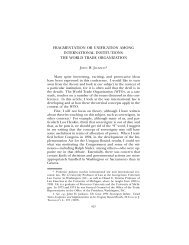some concluding remarks - Project on International Courts and ...
some concluding remarks - Project on International Courts and ...
some concluding remarks - Project on International Courts and ...
Create successful ePaper yourself
Turn your PDF publications into a flip-book with our unique Google optimized e-Paper software.
1999] CONCLUDING REMARKS 927tem can develop through the “cumulative process” of internati<strong>on</strong>allaw, of which custom is the most visible, but not the<strong>on</strong>ly, example. This process would progressively c<strong>on</strong>dense <strong>and</strong>crystallize the different particles of c<strong>on</strong>sensual or authoritativejurisdicti<strong>on</strong>al empowerment into a certain structure. 5However, this process depends <strong>on</strong> the behavior of the relevantlegal actors. These are not <strong>on</strong>ly states—whether as litigantsor when creating or referring a case to a tribunal byagreement—but also the courts <strong>and</strong> tribunals themselves, aswell as organs of internati<strong>on</strong>al organizati<strong>on</strong>s when creatingtribunals in the exercise of their c<strong>on</strong>stituti<strong>on</strong>al powers. Theprocess can operate <strong>on</strong>ly if these actors are c<strong>on</strong>scious of theobjective (the need for a judicial system <strong>and</strong> the requirementsof such a development) <strong>and</strong> if they seize <strong>on</strong> all opportunitiesto inch the process in this directi<strong>on</strong>.Such opportunities are present “at the creati<strong>on</strong>”—that is,when establishing a new arbitral or judicial organ. As menti<strong>on</strong>edearlier, <strong>on</strong> two occasi<strong>on</strong>s, a case was introduced beforethe ICJ c<strong>on</strong>testing the validity of a prior arbitral award. Thesecases were introduced as new cases, by virtue of a separate jurisdicti<strong>on</strong>altitle, other than the <strong>on</strong>e at the basis of the initialarbitrati<strong>on</strong>. However, such an appeal can be provided for inthe compromise or compromissory clause that creates or refersto the arbitral tribunal. If such a provisi<strong>on</strong> were generalizedin arbitrati<strong>on</strong> treaties to the point of becoming a clause destyle, we might reach Professor Scelle’s soluti<strong>on</strong> through a processfrom below.More important, from a practical point of view, are theexamples of appeal from the decisi<strong>on</strong>s of the Mixed ArbitralTribunals to the PCIJ, <strong>and</strong> from the decisi<strong>on</strong>s of the AdministrativeTribunals of the UN <strong>and</strong> the ILO to the ICJ, through arequest for an advisory opini<strong>on</strong>. C<strong>on</strong>sidering that much of therecent judicial “proliferati<strong>on</strong>” took place within the UN (thead hoc Internati<strong>on</strong>al Criminal Tribunals), under its auspices(the Law of the Sea Tribunal <strong>and</strong> the ICC), or within its spe-5. I have argued elsewhere, al<strong>on</strong>g the same lines, that internati<strong>on</strong>al lawhas developed a “legislative process” in the absence of a centralized legislativepower. See Georges Abi-Saab, La coutume dans tous ses états, ou le dilemmedu développement du droit internati<strong>on</strong>al général dans un m<strong>on</strong>de éclaté, in 1 INTER-NATIONAL LAW AT THE TIME OF ITS CODIFICATION: ESSAYS IN HONOUR OF RO-BERTO AGO 53 (Giuffrè 1987).






